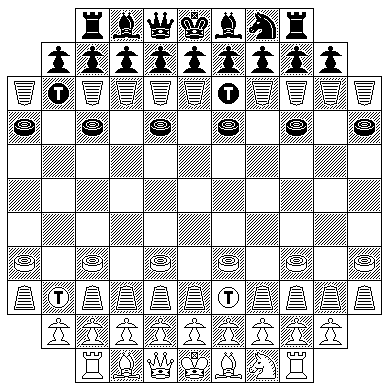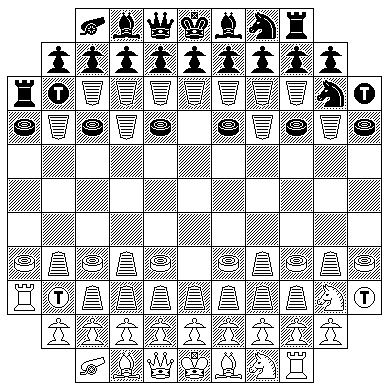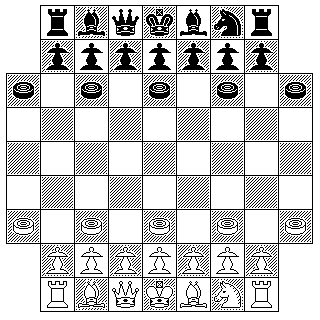
How can one make Chess more exciting and interesting through changing it in the obvious way of adding pieces with new powers of movement?
Particularly when "exciting" and "interesting" are meant primarily from the viewpoint of the spectator, Chess being unsatisfactory in that respect since Steinitz, but still being perfectly satisfactory for those who play it?
I had thought that adding pieces to the game with new powers of movement was the wrong way to go about this, and instead changing how points are awarded for winning, as in my proposal of Dynamic Scoring, was instead a more fruitful approach. While I still do largely hold that opinion, I have given some thought to what possibilities the usual approach might have.
In particular, the historical temptation to combine Checkers with Chess has led me to think about whether that approach might hold some promise.
The board and initial array of the game I now describe is shown below:

The board is 11 by 11, with three squares removed at each corner, giving it a somewhat octagonal shape.
Thus, each player has seven pieces on the back rank; these are arrayed as in conventional Chess, except that the Queen's Knight is omitted for both players.
The rule of Castling is the same as in conventional Chess, but now Castling on the Queen's side is fully the equal of Castling on the King's side, instead of providing a somewhat inferior degree of security for the King.
The second rank contains nine Pawns for each player. Their move is also precisely as in Chess, including a double-step first move and en passant capture.
Pawns promote when they reach a square at the other end of the board from which they cannot move forwards in their normal move without capturing. Thus, at the edge of the board, a Pawn might promote on the tenth rank, or even the ninth rank, instead of the eleventh rank.
A Pawn may not promote to an unpromoted Checker, or an unpromoted Soldier, or to a Pawn or to a King, but a Pawn may promote to a promoted Soldier, and, if it promotes on a black square, it may also promote to a promoted Checker.
The third rank contains nine Soldiers and two Tigers.
The Tiger is a piece we have met before. It moves as a Bishop, but captures as a Knight. Note that the Tiger on a black square is blocked by Checkers in front of it, just as the pieces on the back rank have Pawns in front of them, at the start of the game; the Tiger on a white square has an unobstructed path, but since it is centrally located, it does not immediately threaten the opponent at the beginning.
The Soldier moves one space orthogonally forwards, or one space orthogonally sideways.
When it makes a move that ends in a square in the last three ranks of the board, it may optionally be promoted, by turning it over. Since in this game, unlike Shogi, there is only one piece that promotes in this fashion, the promoted side of the piece could be marked very simply, for example with a dot. A promoted Soldier may move orthogonally backwards in addition to the three other moves of an unpromoted Soldier.
Soldiers capture by custodian capture. A Soldier captures an enemy piece, other than the enemy King, by moving to a square beside that piece, if another piece of the player to whom the Soldier belongs, which need not be a Soldier itself, is on the opposite side of that piece. The enemy piece must be surrounded orthogonally, not diagonally.
If a piece is in one of the twelve corner squares of the board, it may be captured when a Soldier becomes the second piece belonging to the opposing player that is orthogonally adjacent to it, since placing two pieces on opposite sides is not possible when a piece is in a corner.
A Soldier gives check to the enemy King, on the other hand, only when it threatens to move to a square orthogonally adjacent to that King so that the enemy King is surrounded on all available orthogonally adjacent squares (four in the middle of the board, three on the edge, or two in a corner square) by pieces belonging to the same player as the Soldier.
Thus, this rule is similar to the rule of capture in Tablut, although Soldiers move one square at a time, not like Rooks.
Note that the Soldiers of both sides are shown as being of the same color, a color neither black nor white. But they are pointed in opposide directions, and they are shaped like Shogi pieces.
And, indeed, when a player has captured a Soldier, whether promoted or unpromoted, he may, instead of making a move, enter a captured Soldier on the board as one of his own, in unpromoted form. As in Shogi, a re-entered Soldier would promote as soon as it makes a move that leaves it in the last three rows of the board, and this applies even if it was entered on the last three rows of the board.
This re-entry may not be a capturing move, but it may threaten capture or give check.
It may also be used to block a check by interposition.
On the fourth rank, each player has six Checkers.
They move like the pieces in English Draughts. They move one space diagonally forwards. They capture by jumping over a piece in a square to which they could otherwise move to the immediately adjacent square beyond. They may make multiple captures, but an unpromoted Checker may only capture in a forwards direction.
It is not compulsory for a Checker to capture one of the opponent's pieces other than a Checker.
However, it is compulsory for any piece, other than the King, to capture a Checker that it is able to capture, unless some other move that also captures an opponent's Checker, or that gives check, can be made.
The intent behind the design of this game is to take the old idea of combining Chess with Checkers one step further, by throwing in Shogi and one possible reconstruction of Ludus Latrunculorum into the mix as well.
The Soldiers, having only the power of custodian capture, would seem to be so weak as to be scarcely worth considering; but because they can be re-entered on the board like pieces in Shogi, the number of those pieces at least potentially available does not decrease during a game, and so they could be decisive in the endgame when everything else but the Kings has been captured.
The Checkers, on the other hand, since they have the power to compel other pieces to capture them, are extremely dangerous and powerful pieces. It is presumed that players will normally make it their first order of business to capture all the opponent's Checkers at the beginning of a game. Underpromoting a Pawn to a promoted Checker may be a real option under some circumstances.
One possible alteration to the form of the game as depicted would be to omit the two Tigers, and replace them by additional Soldiers, to keep the layout of the board simple.
Another possible change would be to do away with the option of re-entering captured Soldiers into the game as being simply too complicated.
However, if it is accepted that re-entering Soldiers is helpful to the game, and the Tigers, which switch from being on opposite colors to being both on the same color, or vice versa, with every capture, are helpful, then instead it might be lamented that one other additional complexity is missing from the game: the Cannon from Chinese Chess.
Here is an alternate layout which adds the Cannon:

Now there are a full eleven Soldiers on each side, and each side has two Knights as well as still having two Rooks.
However, the Queen's Rook is replaced by a Cannon, with the second rook now located in the third rank. Queen's side Castling is still to be possible, with the Cannon participating in Castling by moving exactly as the Queen's Rook would have done, jumping over the King that had moved two squares towards it to the square immediately beyond.
By having additional Soldiers in the same row as the Checkers, the two Tigers and the Rook and Knight are now behind Soldiers and Checkers exactly as pieces in Chess are behind the Pawns.
Moving in the opposite direction, and striving for the maximum of simplicity while retaining the essential innovations of this game,

the above illustrates a game on a 9 by 9 board which does without the Soldiers entirely.